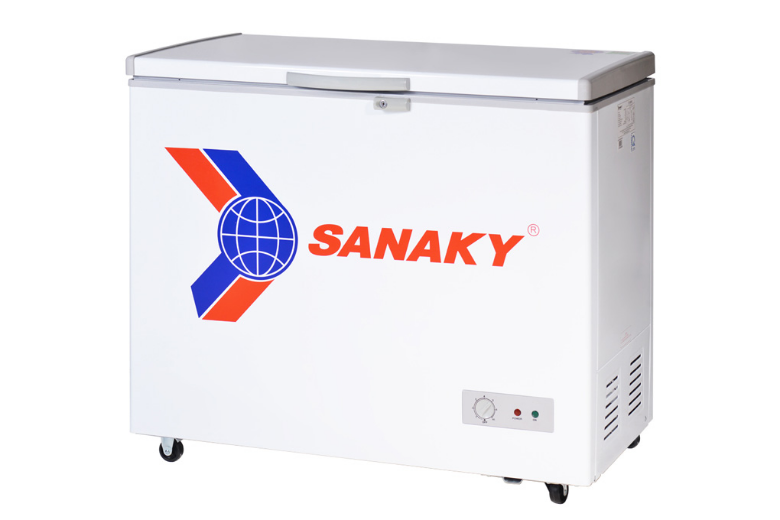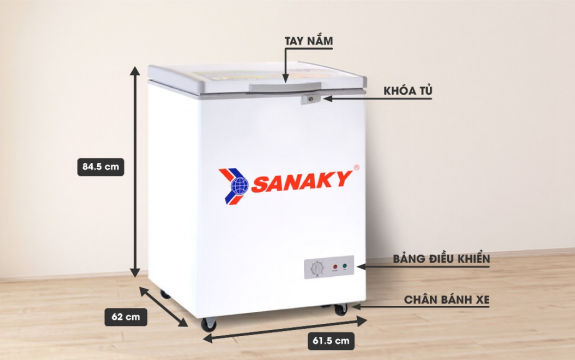In an era where smart living and savvy shopping are paramount, the chest freezer has emerged as an indispensable appliance for homes and businesses alike. Far more than just an extra storage unit, a chest freezer is a powerful tool for maximizing food freshness, capitalizing on bulk deals, and significantly reducing food waste. If you're constantly battling for space in your main refrigerator's freezer compartment, or if you're looking for a way to save money on groceries, a chest freezer might just be the perfect solution you never knew you needed.
This comprehensive guide will explore everything you need to know about chest freezers, from their core benefits and essential features to maintenance tips and how to choose the ideal model for your specific needs.
1. Why a Chest Freezer is a Smart Investment for Your Home or Business

The benefits of owning a chest freezer extend far beyond simple storage. They offer tangible advantages that can impact your budget, convenience, and overall food management:
Maximize Storage Space: Chest freezers are renowned for their generous, unobstructed interior space. Unlike upright freezers with shelves and drawers that can limit bulky items, a chest freezer provides an open cavity, making it perfect for storing large cuts of meat, bulk purchases, large batch-cooked meals, or even odd-shaped items like a whole turkey. Say goodbye to cramped freezer compartments!
Significant Cost Savings:
- Bulk Buying: Chest freezers allow you to take full advantage of sales, discounts, and wholesale pricing on perishable goods. Buying larger quantities of meat, poultry, seafood, or frozen vegetables when they're on offer can lead to substantial savings over time.
- Reducing Food Waste: By freezing leftovers, preserving seasonal fruits and vegetables at their peak, or safely storing produce nearing its expiration date, you dramatically cut down on food spoilage, turning potential waste into savings.
Convenience and Meal Prep:
- Hassle-Free Meal Planning: A well-stocked chest freezer simplifies meal preparation. You can batch-cook favorite dishes, freeze them in individual portions, and have ready-made meals for busy weeknights, saving valuable time and effort.
- Emergency Preparedness: In case of power outages, chest freezers are generally superior at maintaining colder temperatures longer than upright freezers due to their top-opening design, which traps cold air inside. This means your food stays frozen for extended periods, reducing spoilage risk.
Preserving Seasonal Delights: If you love gardening or enjoy fresh, seasonal produce, a chest freezer allows you to preserve the bounty of the harvest year-round. Freeze berries, peaches, corn, or beans when they are at their freshest and most flavorful.
Specialized Storage: For hunters, fishermen, or those with unique dietary needs, a chest freezer offers dedicated space for large game, fresh catches, or specific dietary preparations.
2. Key Features to Consider When Buying Your Chest Freezer
Choosing the right chest freezer involves more than just picking the biggest one. Here are the crucial features to look for:
2.1. Capacity and Size
Chest freezers are measured by their internal capacity, typically in cubic feet (cu. ft.) or liters (L). Understanding your needs is key. A compact model (around 3-5 cu. ft. or 100-150L) might be ideal for individuals or small apartments, serving as a secondary freezer for extra items. Small freezers (5-9 cu. ft. or 150-250L) are suitable for small families or those who buy a moderate amount in bulk. Medium-sized units (10-16 cu. ft. or 250-450L) are a popular choice for average-sized families who regularly buy in bulk or enjoy batch cooking. For large families, avid hunters or fishermen, or small businesses like restaurants or catering services, large chest freezers (17+ cu. ft. or 450L+) are essential. As a general rule, 1 cubic foot can typically hold about 35-40 lbs (approximately 16-18 kg) of frozen food. Beyond internal volume, remember to consider the physical dimensions – width, height, and depth – to ensure the freezer fits comfortably in your designated space, always allowing at least 3 inches of clearance on all sides for proper air circulation.

2.2. Energy Efficiency
This is a critical factor for long-term savings on your utility bills. Always look for the ENERGY STAR® rating label. Chest freezers with this certification are specifically designed to consume less energy, leading to significant financial savings over the appliance's lifespan. The quality of insulation also plays a vital role; thicker, high-quality insulation helps the freezer maintain stable internal temperatures, which in turn reduces how often the compressor needs to run, further cutting down on electricity consumption. Investing in an energy-efficient chest freezer is a smart move for both your wallet and the environment.
2.3. Temperature Control and Features
A reliable freezer needs precise temperature control. Look for an adjustable thermostat that allows you to set the optimal freezing temperature, which is generally 0°F (-18°C) for safe long-term food storage. A "Fast Freeze" or "Quick Freeze" setting is highly beneficial; this feature temporarily lowers the temperature to rapidly freeze newly added items, effectively locking in their freshness, texture, and nutrients. For added peace of mind, a temperature alarm can alert you if the internal temperature rises above a safe level, protecting your valuable food from spoilage. Lastly, a simple but vital power on indicator light visually confirms that the unit is powered and operating correctly.
3. Chest Freezer vs. Upright Freezer: Making the Right Choice
While both chest freezers and upright freezers serve the essential purpose of freezing food, their design leads to distinct advantages and disadvantages, making one potentially more suitable for your specific needs than the other.
A chest freezer typically has a wider footprint, meaning it requires more horizontal space. This design makes them ideal for locations like garages, basements, or dedicated utility rooms where floor space isn't as critical as in a main kitchen. Their deep bin-like interior, while offering massive, unobstructed storage capacity, can sometimes make organization a bit challenging, often relying on removable baskets to keep smaller items accessible. One of their most significant advantages is energy efficiency; their top-opening lid helps trap cold air inside, as cold air naturally sinks, making them generally more efficient than upright models. However, most chest freezers require manual defrosting, which, while more energy-efficient, demands periodic effort to remove ice buildup. In terms of cost, chest freezers are often less expensive for the same internal capacity. Crucially, during a power outage, a full chest freezer can retain its cold temperatures for a much longer period, often up to 2-3 days, thanks to its superior insulation and design that minimizes cold air escape.
Conversely, an upright freezer has a taller, narrower footprint, making it a better fit for kitchens or spaces where floor area is limited. Their internal design with shelves and door bins offers highly organized and easy access to frozen items, much like a regular refrigerator. However, this internal shelving can limit the storage of very bulky or oddly shaped items. Upright freezers tend to be less energy-efficient than chest freezers because cold air can escape more easily when the front-opening door is opened. They often feature "frost-free" or automatic defrosting systems, which are highly convenient as they eliminate the need for manual defrosting, but this convenience comes at the cost of higher energy consumption and can sometimes lead to minor freezer burn if food isn't properly wrapped. Upright freezers are typically more expensive than chest freezers for the same capacity. In a power outage, an upright freezer usually retains cold for a shorter period, approximately one day, due to its front-opening design. Your choice ultimately depends on your available space, organizational preferences, budget, and priority for energy efficiency versus convenience.
4. Placement and Maintenance Tips for Optimal Performance
To ensure your chest freezer operates efficiently, maximizes its lifespan, and truly lives up to its energy-saving potential, proper placement and consistent maintenance are key:
Optimal Placement: Choose a cool, dry area for your freezer, away from direct sunlight, heat sources like ovens, radiators, or even other large appliances that generate heat. Adequate air circulation around the unit is crucial for its cooling system to work efficiently; ensure there's at least 3 inches of space around the sides and back. Always place your freezer on a hard, level surface, avoiding carpets which can impede ventilation or lead to instability.
Fill It Up (Strategically): A full freezer runs more efficiently than an empty one. Frozen items act as insulation, helping to maintain colder temperatures and reducing the workload on the compressor. If you find yourself with empty space, fill it with crumpled newspaper or water jugs (leaving room for expansion) to help stabilize the temperature.
Don't Overload: While filling your freezer is good, avoid packing it so tightly that air cannot circulate between items. Hindered air circulation can reduce freezing performance and strain the compressor.
Regular Defrosting: For most manual defrost chest freezer models, you'll need to defrost it periodically. The general rule of thumb is to defrost when ice buildup on the interior walls exceeds ¼ to ½ inch. Excessive frost reduces efficiency and usable storage space. To defrost: unplug the unit, remove all food (store it in coolers with ice packs), open the lid, and allow the ice to melt naturally. You can speed up the process by placing bowls of hot water inside. Once all ice has melted, clean the interior thoroughly with a mild soap solution, rinse with clean water, and dry completely before plugging it back in and returning food.
Clean Condenser Coils: On the back or bottom of the freezer, the condenser coils can collect dust and debris. This accumulation reduces the freezer's efficiency by impeding heat dissipation. Vacuum these coils at least once a year to maintain optimal performance.
Check Door Seals (Gaskets): Regularly inspect the rubber seal around the lid. It should be clean, pliable, and free of cracks or tears. A tight seal is absolutely crucial to prevent cold air from escaping and warm air from entering. You can test the seal by closing the lid on a dollar bill; if it slides out easily, the seal might need cleaning, re-alignment, or even replacing.
Avoid Frequent Opening: Every time you open the lid, cold air escapes, and warm air enters, forcing the compressor to work harder to bring the temperature back down. Open the lid only when necessary and close it quickly.
Set the Right Temperature: Use a dedicated freezer thermometer to monitor the internal temperature. Maintain your freezer at a consistent 0°F (-18°C) or colder for safe long-term food storage and optimal energy efficiency.
A chest freezer is a powerful asset in any home or commercial setting, offering unparalleled capacity, superior energy efficiency, and reliable long-term food preservation. By enabling smart bulk purchasing, significantly reducing food waste, and simplifying meal preparation, it provides substantial economic and practical benefits that far outweigh its initial cost. When it comes to choosing the right model, prioritize capacity that truly meets your needs, opt for high energy efficiency to ensure long-term savings, and consider convenience features that align with your lifestyle. With proper placement and consistent maintenance, your chest freezer will be a diligent, silent workhorse, safeguarding your valuable food and contributing to a more organized, economical, and convenient way of living for years to come.
--------------------------------------------------------------------------------------------------------------
SANAKY VIETNAM., CO LTD - Manufacturer of Chest Freezer - Upright Cooler, Transformer, RO Water Purifier...
 Vietnamese
Vietnamese  English
English  Chinese
Chinese  French
French  Spanish
Spanish  Russian
Russian  Arabic
Arabic  Portuguese
Portuguese